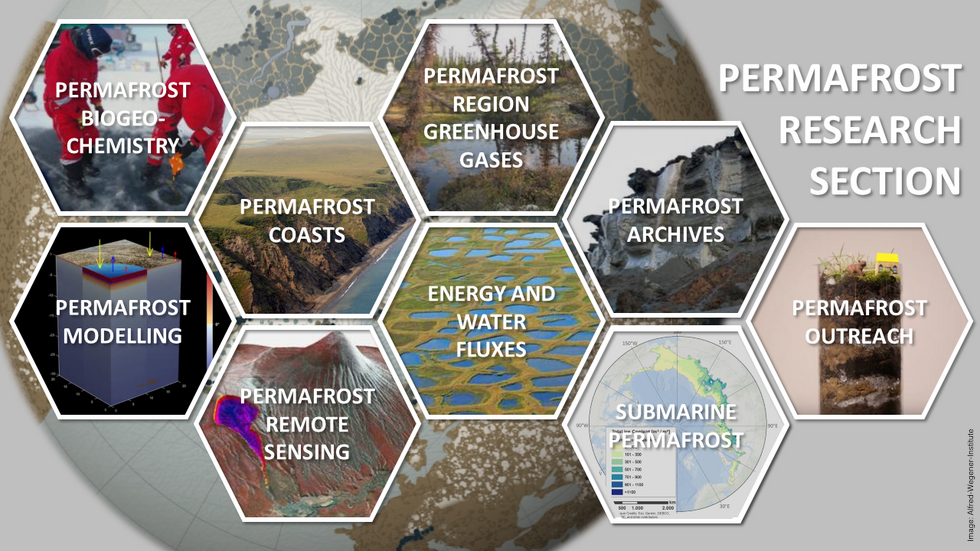Permafrost Research Section of the Alfred-Wegener-Institute
Permafrost thaw and collapse is one of the most serious climate change threats to people within and beyond the Arctic in this century. The Arctic is warming up to four times faster than the global average. This threatens the permanently frozen ground, also called permafrost, which affects 22 percent of the land surface in the northern hemisphere. Arctic permafrost stores large amounts of carbon, it accounts for nearly half of all organic carbon stored in global soils. Thawing permafrost will further accelerate the warming of the Earth through the release of carbon dioxide and methane.
For decades permafrost temperatures have been rising across the Arctic. Longer and deeper thaw causes ice contained in frozen ground to melt. The resulting terrain subsidence damages infrastructure and causes irreversible changes of landscapes and ecosystems. Arctic permafrost regions are the homeland to 4.9 million people. Indigenous peoples in the Arctic are particularly affected by thawing permafrost in their traditional subsistence lifestyles, economies, and food security.
Watch this video for a short introduction on the topic permafrost: https://youtu.be/lxixy1u8GjY
Research objectives
- Observe and quantify the modern and past state of terrestrial and submarine permafrost and predict its future transformation in a changing climate.
- Measure long-term hydroclimate and ground temperatures, study water and energy balance, use remote sensing to quantify thaw, and model past, current, and future permafrost.
- Employ geophysics, quantify matter fluxes from permafrost thaw and coastal erosion, and determine greenhouse gas and biogeochemical fluxes in the permafrost region.
- Reconstruct periglacial landscape dynamics over the past 700,000 years, studying ecosystem dynamics and the biogeochemical cycles in the terrestrial Arctic using multiproxy analyses of permafrost and lacustrine records.
Methods
- Geological and cryo-stratigraphical, studies of permafrost and lake sediment cores as well as of natural exposures along sea coasts, river banks, and lake shores
- Sedimentological, geochronological, paleontological, biogeochemical, mineralogical, hydrochemical, and stable isotopic analyses
- Continuous measurements of hydroclimatic data and permafrost temperatures
- Study of water and energy balances of typical permafrost landscapes
- Large-scale and high-resolution remote sensing of landscape changes caused by permafrost degradation
- Numerical modelling of terrestrial and subaquatic permafrost characteristics and landscape dynamics under past, current, and future environmental conditions
- The study of permafrost characteristics using geophysical and further field analytical methods
- Quantification of sediment and geochemical fluxes due to Arctic streams and from coastal erosion
- Characterization of permafrost soils and deposits biogeochemistry, including stocks and fluxes of carbon and nitrogen and other chemical element dynamics (e.g. mercury)
- Quantification of changes in organic matter stocks, their quality and lability, and greenhouse gas production in response to permafrost thaw using laboratory experiments
Rseponsible persons
Permafrost Research Section of the Alfred-Wegener-Institut, Helmholtz-Zentrum für Polar- und Meeresforschung (AWI, Potsdam)
- Prof. Dr. Guido Grosse (Section head)
- Prof. Dr. Julia Boike (Deputy Section head)
Projects we participate in
Nunataryuk
EU Horizon2020 Project
PermaRisk
BMBF Young Investigator Group
FluxWin
EU Horizon2020 ERC Young Investigator Group
UndercoverEisAgenten
BMBF Citizen Science Project
Arctic PASSION
EU Horizon2020 Project
CCI+ Permafrost
ESA project for quantifying permafrost change with Earth Observation methods
AMPAC-Net
ESA ESA project for coordinating methane synthesis research for permafrost regions
EO4PAC
ESA project for monitoring Arctic coastal erosion
ML4Earth
BMBF project for applying machine learning methods in Earth Observation
HIT
Helmholtz Imaging Platform: The Hidden Image of Thawing Permafrost
MISO
EU Horizon2020 Project for developing autonomous methane observation system for deployment in the Arctic (no website yet)
